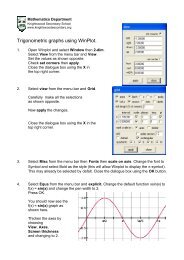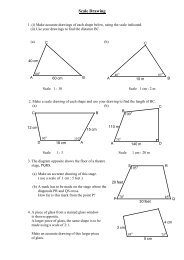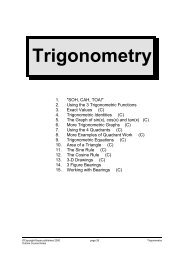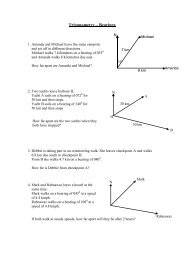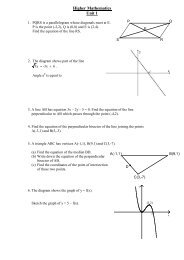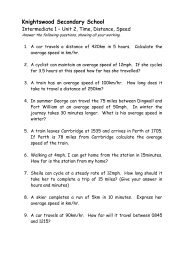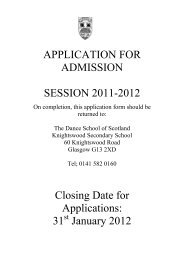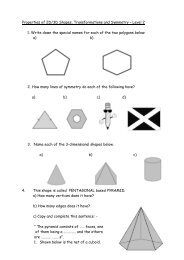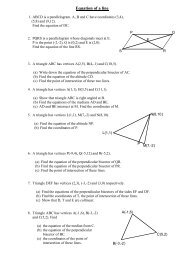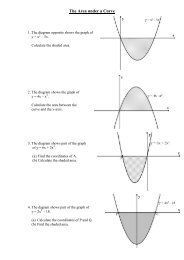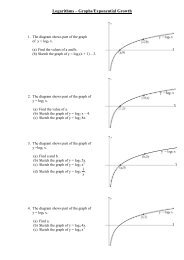Joint Variation - Knightswood Secondary School
Joint Variation - Knightswood Secondary School
Joint Variation - Knightswood Secondary School
Create successful ePaper yourself
Turn your PDF publications into a flip-book with our unique Google optimized e-Paper software.
<strong>Joint</strong> <strong>Variation</strong><br />
1. P varies jointly with Q and R. When P = 98, Q = 2 and R = 7.<br />
Find an equation connecting P, Q and R. hence find P when Q = 15 and<br />
R = 8.<br />
2. A varies as the square of B and inversely as C. When A is 6, B is 5 and<br />
C = 100.<br />
Calculate A when B is 12 and C = 72.<br />
3. H varies directly as the square of L and inversely as the square root of M.<br />
When H is 10, L is 4 and m is 64.<br />
(a) Find an equation connecting H, L and M.<br />
(b) Find H when L is 12 and M is 256.<br />
4. M varies as N and as the square root of P. When M = 9, N = 3 and P = 36.<br />
Calculate N when M = 20 and P = 100.<br />
5. The safe load W of a beam supported at each end varies as the breadth of<br />
the beam b and the square of its depth d. It also varies inversely as the<br />
distance x between the beams.<br />
It is known that W = 8400 when b = 7.5, d = 5 and x = 5.<br />
(a) Find a formula for W in terms of b, d and x.<br />
(b) Find W given b = 6, d = 12 and x = 4.<br />
6. The volume, V cubic centimetres, of a certain gas varies directly as the<br />
temperature, t o , and inversely as the pressure, P mmHg.<br />
At a temperature of 250 0 and a pressure of 750 mmHg, the volume is<br />
200 cm 3 .<br />
(a) Find a formula connecting V, t and P.<br />
(b) Calculate the volume of the gas at a temperature of 350 0 and a<br />
pressure of 1000mmHg.<br />
7. The time, t seconds, taken by a child to slide down a chute varies<br />
directly as the length, L metres, of the chute and the inversely as<br />
the square root of the height, H metres, of the chute above the<br />
ground.<br />
It takes 10 seconds to slide down a chute 3.75 metres long and<br />
2.25 metres high.<br />
How long does it take to slide down a chute 5 metres long which<br />
is 2.56 metres high?
8. The weight, W kilograms, of a cylindrical metal pole varies as its<br />
length, L centimetres, and as the square of its diameter,<br />
D centimetres.<br />
A pole 120 cm long and with diameter 8 cm weighs 14.4 kg.<br />
Calculate the length of a pole with diameter 12 cm and weighing<br />
67.5 kilograms.<br />
9. The number of litres of petrol, L, used by a car on a journey varies<br />
directly as the distance, d km, travelled and as the square root of the<br />
average speed , s kmph.<br />
The car uses 30 litres of petrol for a journey of 550 km at an average<br />
speed of 81 kmph.<br />
(a) Find a formula connecting L, d and s.<br />
(b) How many litres of petrol would be used on a journey of 693 km<br />
at an average speed of 100kmph?<br />
10. The time, T minutes, taken for a stadium to empty varies directly as the<br />
number of spectators, S, and inversely as the number of open exits, E.<br />
It takes 12 minutes for a stadium to empty when there are 20 000<br />
spectators and 20 open exits.<br />
(a) Find a formula connecting T, s and E.<br />
(b) How long does it take to empty the stadium when there are 36 000<br />
spectators and 24 open exits?<br />
11. The force, F newtons, needed to stop a train varies as the square of<br />
the speed, S kmph, of the train and inversely as the stopping<br />
distance, D metres.<br />
It is known a force of 300 newtons is required to stop a train<br />
travelling at a speed of 60 kmph in a distance of 1200 metres.<br />
(a) Calculate the force needed to stop a train travelling at a<br />
speed of 50 kmph in a distance of 800 metres.<br />
(b) Calculate the distance it would take a train to stop if it<br />
was travelling at 40 kmph and a force of 256 newtons<br />
was applied.<br />
12. The time, T hours, taken to harvest an orchard varies directly as<br />
The area, A m 2 , of the orchard and inversely as the number of<br />
workers used, N.<br />
An orchard with an area of 1200 m 2 can be harvested by 8<br />
workers in a time of 6 hours.<br />
How much time could have been saved if 10 workers had been<br />
used to harvest the orchard?
13. As the drum of a washing machine spins it exerts a force on the<br />
clothes inside it, forcing them against the side of the drum.<br />
The force, F newtons, varies directly as the square of the speed<br />
of the drum, S metres per second, and the mass, M kilograms,<br />
of the clothes in the drum and also inversely as the radius of the<br />
drum, R centimetres.<br />
A drum of radius 20 cm spinning at 20 mps and containing 2 kg<br />
of clothes exerts a force of 33.75 newtons.<br />
Calculate the force exerted if this machine spins at the same speed<br />
but the weight of clothes is doubled.<br />
14. The electrical resistance, R, of copper wire varies directly as its<br />
length, L metres, and inversely as the square of its diameter<br />
D millimetres.<br />
A piece of copper wire 8 metres long with diameter 4 millimetres<br />
has resistance 7.5.<br />
Calculate the resistance of a piece of copper wire 10 metres long<br />
with diameter 2.5 millimetres.



